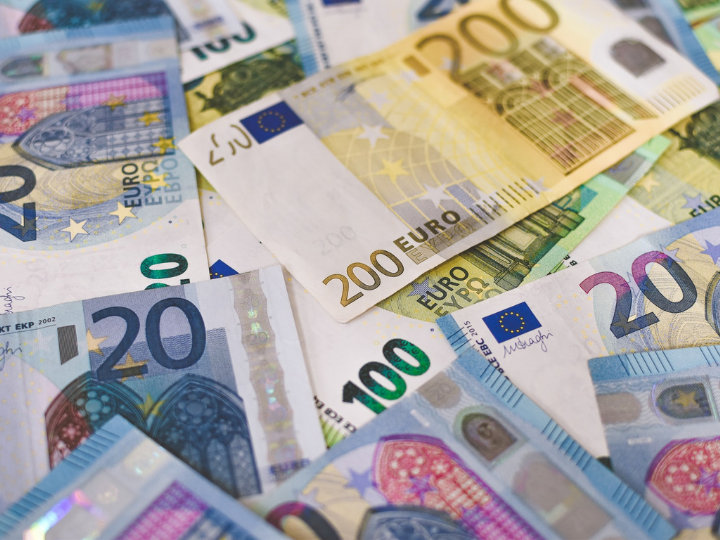by Esther Snippe and Janos Ammann
Although officially introduced on 1 January 1999, the euro became a tangible reality for most Europeans on 1 January 2002, when the first euro coins and banknotes were put into circulation.
The following six graphs are glimpses into the history of the European currency with some of its successes, shortcomings, and absurdities.
1. How many euro banknotes are there?
In November 2021, a grand total of 27,640,019,753 euro banknotes with a total value of 1,519 billion euros were in circulation, according to the European Central Bank (ECB). Additionally, 141 billion coins, worth 31 billion euros in total, circulated through wallets, supermarket cash registers, trouser pockets, and underneath couch cushions.
Even though more consumers have been paying cashless, the amount of euro banknotes in circulation has risen, and the growth even picked up in the past two years. European Central Bank researchers pointed out that euro banknotes are increasingly used as a store of value, both within the eurozone and outside of it. This might be especially relevant during the crisis caused by the pandemic.
“One possible explanation […] is that during the crisis people turned to cash as a tool to manage uncertainty,” argued Fabio Panetta, member of the ECB’s executive board.
“Faster digitalisation does not spell the end for cash any time soon,” he said.
Even the amount of euro coins in circulation is still rising. The most numerous coin is the 1-cent coin, with 38 billion coins worth €380 million in circulation. If all of them were stacked on top of each other, this thin tower would reach 63,460 km into space, about a sixth of the way to the moon.
2. The ECB balance sheet as a history book
The history of the euro has been short but turbulent: The great recession of 2008, the eurozone crisis of 2010, the deflationary pressures of 2015-2019, and the pandemic have all left their mark on the ECB’s balance sheet.
The cumulative effect of the ECB reactions to these events led to a nine-fold increase of the assets on the ECB balance sheet from 1999 to 2021.
Moreover, the changing composition of the ECB balance sheet shows the different ways in which the guardian of the euro has reacted to the challenges of the time.
For example, the category “Lending to euro area credit institutions in euro” (blue area in the graph) shows how the ECB made use of long term refinancing operations (LTRO) in crises. In 2008, 2012, and 2020, the ECB provided European banks with cheap lending by means of these LTROs so that banks would keep on lending to the real economy.
The rise of the category “Securities of euro area residents” (green area in the graph) shows the start of the quantitative easing (QE) program in early 2015.
As the eurozone was in danger of falling into deflation, the ECB under its then-president Mario Draghi started buying massive amounts of government bonds and corporate securities. The aim was to keep the financing conditions attractive for productive investments so that a more heated European economy would counteract the deflationary pressures.
The asset purchases had stopped for some time in 2019, but then picked up again to reach a total of more than €3.2 trillion at the end of 2021.
3. The enduring dominance of the US dollar
One of the goals of the euro was to challenge the global dominance of the US dollar as a reserve currency. Although the euro quickly established itself as the second most important currency, with about 21% of global foreign exchange reserves denominated in euros today, it is still nowhere near challenging the role of the USD.
Compared to earlier in the history of the euro, the role of the euro now seems to have diminished. In early 2010, the euro accounted for 27% of global foreign exchange reserves.
Moreover, a majority of international trade that does not happen between EU countries is denominated in USD. This gives the US a geopolitical lever, as it can ban countries, companies or individuals from making transactions in USD or holding USD-denominated assets, essentially excluding them from the global trade system.
The EU felt this enduring US dominance when the US stepped back from the nuclear deal with Iran and unilaterally enforced harsh economic sanctions on Iran. A strengthened international role of the euro is therefore one of the preconditions of more “strategic autonomy” for the EU.
4. How Germany got its way, part 1
Considerations of the political consequences of currencies have always been at the forefront of French thinking on the euro. The French government wanted to be less dependent on the US and also wanted to counteract the German dominance within Europe.
When Germany wanted to reunite, the French government agreed, but on condition that a common currency is established, aiming to reign in German dominance.
Many Germans feared that they might lose an independent central bank as its main monetary institution, which could then lead to inflation. The spectre of the Weimar-era hyperinflation still haunting German conscience, the Berlin government made sure to enshrine price stability as the only primary objective of an independent European Central Bank.
And it seems to have worked out from a German perspective, although inflation also remained low due to factors other than central bank independence. Inflation in Germany stayed very low after the introduction of the euro.
In 2021, a steep rise in inflation (not visible in the graph above) has led to renewed fears that inflation might run out of control. In Germany, politicians were quick to blame the ECB’s low interest rates. However, the current pandemic-related inflation has its origins in high energy prices and other supply chain difficulties that the ECB cannot directly influence.
5. How Germany got its way, part 2
If Germany got its way in terms of central bank independence and controlled inflation, did France at least achieve a rebalancing of economic power within Europe?
Not really.
Without the euro, the German D-Mark would have had to appreciate following the strong economic performance in Germany. As a member of the euro, however, the German export industry profited from a relatively cheap currency.
Meanwhile, other European industries suffered from a relatively expensive currency, making them less competitive in global markets.
This imbalance is most visible in the current account balance of eurozone countries. Germany had a current account surplus of €230 billion even in 2020, when the pandemic disrupted global trade. This means that Germany exported much more goods than it imported.
Meanwhile, France had a current account deficit of €44 billion. The fact that less productive countries cannot devalue their currency to offset the competitive disadvantage led to social problems, mostly in Southern Europe. Eurozone countries could only hope to remain competitive by lowering labour costs, meaning lower wages or lower social protection.
The problem is exacerbated by the fact that Germany did not invest or spend its surplus, which would have supported the economy in the entire eurozone.
6 – Where are the bridges seen on euro banknotes?
Ever wondered why you have never crossed the bridges depicted on euro banknotes?
The reason is that they are fictional. Or at least they used to be.
Initially, the banknote designer proposed to depict real bridges, like the Rialto bridge in Venice. However, to prevent political bickering over which country’s bridges should be featured on the banknote, the ECB chose to go for stylised model bridges standing for a certain architectural epoch instead of real exemplars.
In 2011, however, the Dutch town of Spijkenisse seized the marketing opportunity to be the only European town represented on the euro banknotes by actually building the seven bridges over its canals.
The effect of Spijkenisse’s ex-post appropriation of the banknote bridges might soon fizzle out, however. In December, the ECB announced it was looking for a new design for the euro banknotes. A decision on the new design is expected in 2024.
*first published in:www.euractiv.com




 By: N. Peter Kramer
By: N. Peter Kramer
